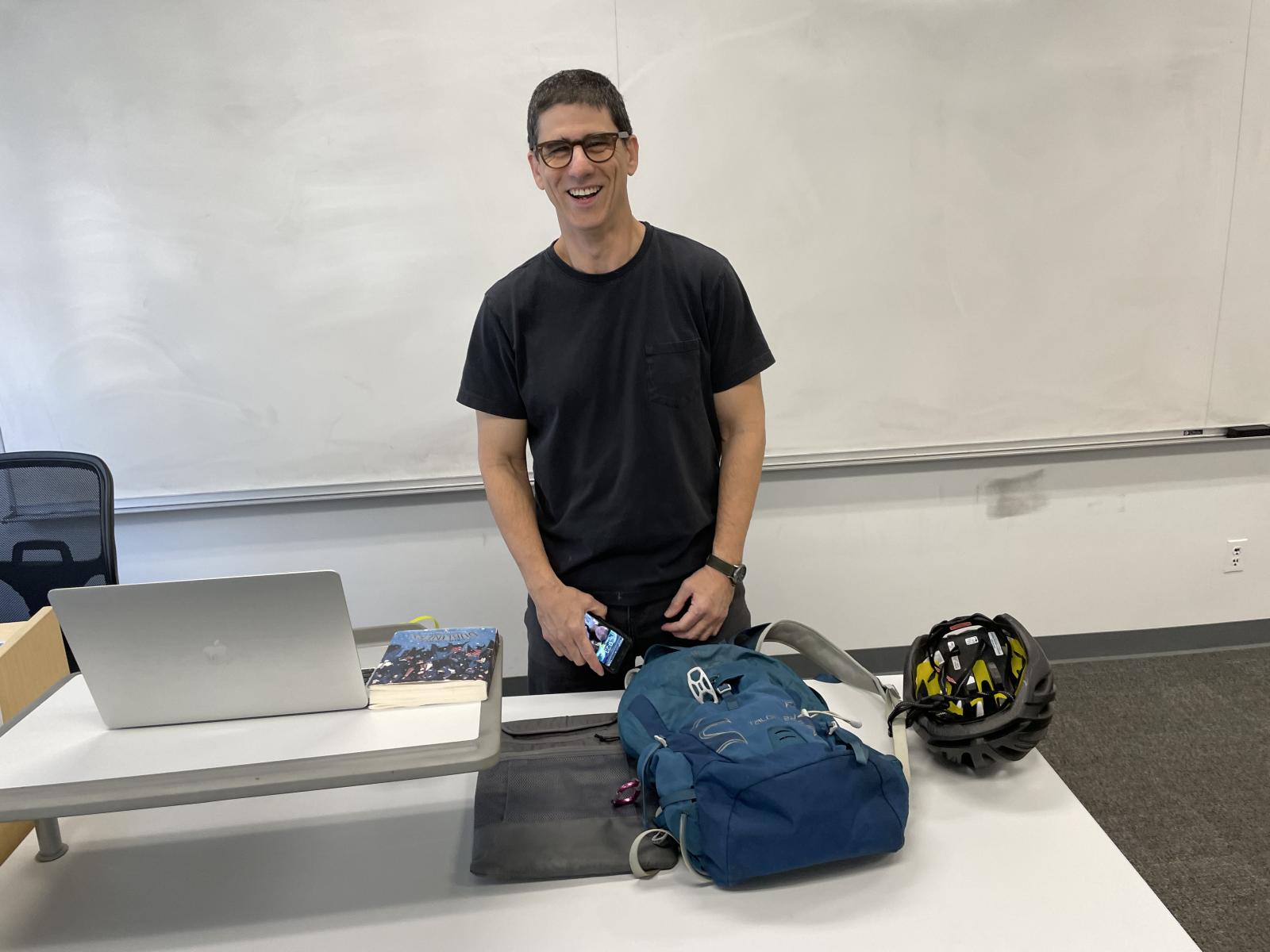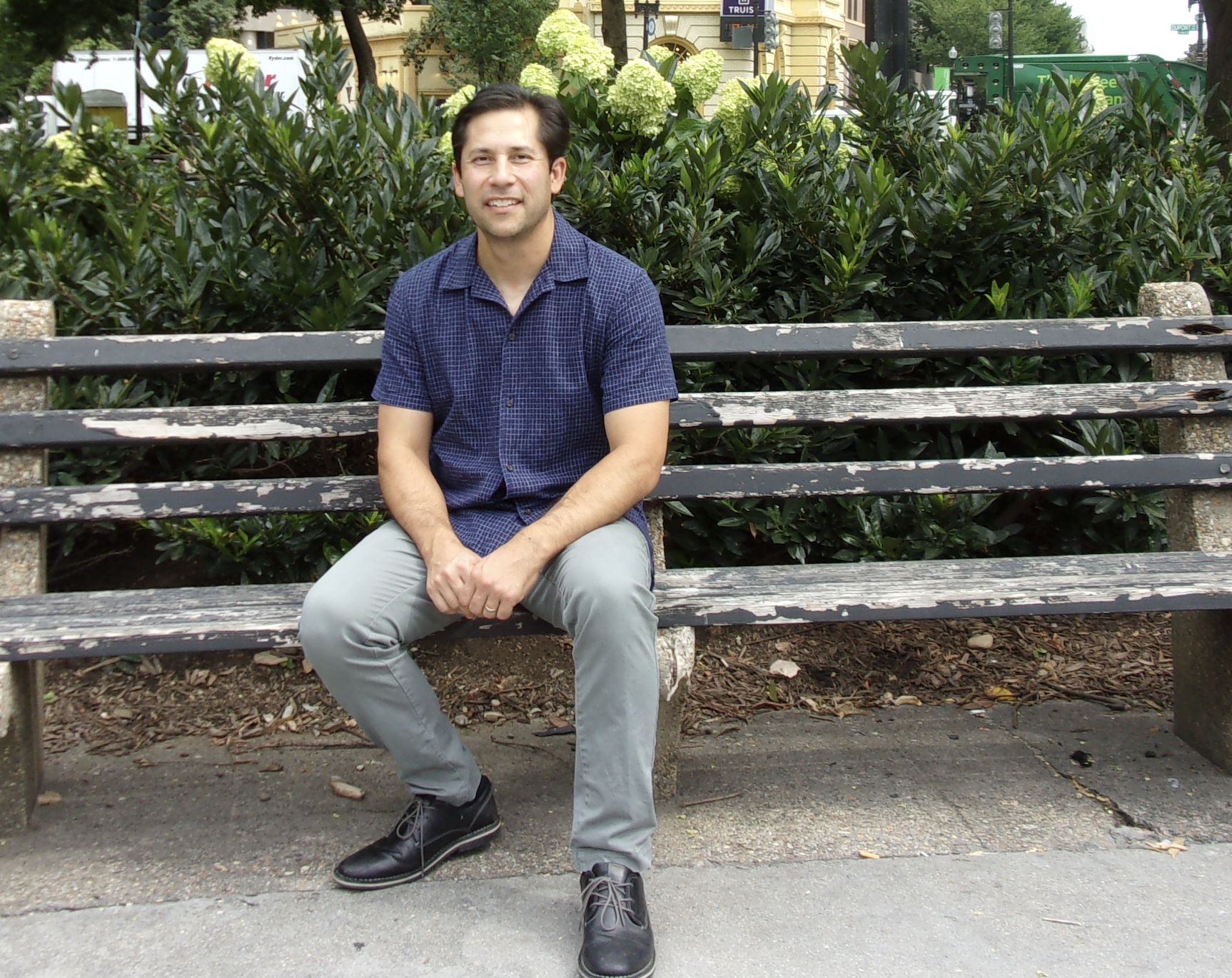All 40 students in Tony López’s Introduction to Literary Studies class are required to contribute in discussion. López, an associate professor of English in the Columbian College of Arts and Sciences, sometimes tells students to turn to the person sitting beside them and discuss the topic at hand. Eventually, he calls on a few people and has them summarize their conversation.
The small classroom feels a bit cramped (“It’s like we’re meeting in the kitchen at a party,” López said). Smiles break out when López self-deprecatingly describes himself as a “nerd,” but mostly the students give him serious attention, which he holds by moving back and forth across the front of the room as he lectures, sometimes kneeling or waving his arms in the air for emphasis. Today, the class is discussing “An Encounter,” from “Dubliners,” a collection of short stories by James Joyce.
Over the course of the semester, the class is studying poems, stories, a play, a film and a novel. López wants students to understand how all of these works can be fruitfully discussed in terms of their form, content and context.
After a few weeks spent reading poetry, “An Encounter” is the first story assigned. On a basic level, it’s about two schoolboys who play hooky and encounter an older man who behaves oddly and talks about whipping boys. López begins by asking how stories and poems differ. A consensus emerges that each presents different kinds of information in different ways. Short stories take more time, compared to a typical poem, to present a narrative using exposition and other elements.
“There’s narrative in poetry too,” López tells the class, “but it’s not the predominant feature, particularly of lyric poetry.” The emphasis in poetry, he adds, tends to be on fewer words, carefully chosen for maximum impact.
López introduces the students to two terms borrowed from the Russian Formalist critics of the early 20th century. Fabula, he tells them, is the Latin word for story; sjuzet is the Russian word for plot. López defines fabula as “the raw material of story events in time order,” and sjuzet as “the arrangement of the raw events.” They can help readers discuss a work not simply by recounting the plot (“two boys skip school and meet a creepy older guy who disturbs the narrator”) but by considering the authorial techniques and strategies involved.
To illustrate, López improvises a story about a knight who arrives at a castle to find a bloodied king. When the knight asks what happened, the king explains that he was attacked by a dragon and asks the knight to kill the monster. The knight travels to the dragon’s cave and, just as he is about to plunge his sword into the beast, it turns into the king, perfectly healthy. “You passed the test,” the king says, explaining that he had asked a wizard to change his appearance to that of a gravely injured man, and then change him into a dragon until the moment just before the knight was going to slay him. The knight slaps the king in the face.
With this cliffhanging example, López shows the class how a story can be made more interesting by its manipulation of time, with the king consulting the wizard before the story opens on the knight’s arrival. The sjuzet, or arrangement of story materials, he says, is like a true-crime podcast, while the fabula is like the Wikipedia entry on the same subject.
He reminds students that they are already familiar with many of the narrative elements and techniques they are examining: “You’ve been storytellers your whole life, listening to and telling stories, and even telling them to yourself.”
Grouped into pairs, the students engage in animated discussion of Joyce’s story, clearly engaged with their introduction to college-level literary analysis.
“I enjoy the way the class sessions are structured with the discussions,” said Alyssa Hughes, a junior majoring in interaction design. “My classmates always say very insightful things that I did not think of.”
Sophomore Nasser Alhajeri, an electrical engineering major, said he enjoys reading short stories and responds positively to López’s enthusiasm.
“He talks like he’s feeling the story,” Alhajeri said. “This gives me the idea that I want to learn. I want to study and come to the next class. It’s a good energy.”
Form, content, context
“When I was in college and even before, I loved reading books,” said López. “And I didn't really have any professional expectations. I figured college is a time to study something that you're interested in that you have a passion for. And that's what I did.”
The titles López is teaching this semester include works it is illuminating for students to compare and contrast, such as Shakespeare’s Sonnet 106 (“When in the chronicle of wasted time…”) and Eduardo C. Corral’s “Border Triptych.”
“Sonnet 106 is a traditional sonnet,” López said. “Eduardo Corral’s ‘Border Triptych’ is a series of three contemporary sonnets about the border between the United States and Mexico and the culture of people crossing it. I want students to see that a poem like ‘Border Triptych,’ by a gay Chicano writer, is tapping into the tradition of the Shakespearean love sonnet, and yet it’s taking that tradition and twisting it.”
Part of the work he asks students to do is figure out how the works on the syllabus connect to them as individuals and to each other.
“I want students to understand that the creativity of a literary work is there to meet their own creativity as responders to literature,” López said. “Their own readings are themselves inspired and creative.”
Other poets on the syllabus include Ada Limón, the first Latina Poet Laureate of the United States, as well as Claude McKay, an important writer of the Harlem Renaissance, and Gertrude Stein. López paired Stein’s “A Carafe, That Is a Blind Glass” (1914) with McKay’s “The Tropics in New York” (1922).
“With McKay and Stein, I teach them two different kinds of modernism,” López said. “We look at Stein’s opaque, abstract modernism, and I invite them to think about how that text is simultaneously a poem and a piece of prose presenting all kinds of resistance to the reader. It isn't giving you its meaning. You have to work. And students work through the difficulty of that language and realize it's being difficult on purpose. And then we look at McKay’s poem, which seems traditional. It's metered and seems to have its meaning right on the surface, about fruits and New York City and missing your homeland of Jamaica. And I tell students, ‘Just as you thought Stein is something you could never understand, this poem is something that you think you understand too well.’”
Of all the works on the reading list, López’s favorite is “The Known World,” a Pulitzer Prize-winning novel by his English Department colleague Edward P. Jones.
“That novel is fantastic. I think it’s a masterpiece. It’s the perfect way to end our class,” he said.
Other works on the syllabus include Herman Melville’s novella “Benito Cereno” and additional stories from Joyce’s “Dubliners,” including “Eveline” and “The Dead,” as well as the play “Top Dog/Underdog” by Suzan-Lori Parks and the movie “Moonlight” directed by Barry Jenkins.
“I’m from Miami,” López said, “and I think ‘Moonlight’ is one of the most important works of art about Miami ever. And I tell students that while not strictly literature in the sense of creative, imaginative, printed material, a film is in our circle of concern as scholars of literature. And if the way we study film in literature class inspires them to become Film Studies students, beautiful! And we begin by asking the same questions: What are the formal properties of the film? What are its content properties? What is the context?”
López is keen on having his students see the connections, sometimes unexpected, between works on his syllabus.
“The protagonist of ‘Evilene’ and the protagonist of ‘Moonlight’ have a lot in common—they're both teenagers with longing,” López said. “What does an Irish girl in 1900 who is thinking about getting on a boat to Argentina have in common with the protagonist of ‘Moonlight,’ who's coming to terms with his gay sexuality and his racial identity and his masculinity and his place in South Florida, a so-called tropical paradise? Those are the kinds of connections we make.”
The skills acquired in this class can benefit students throughout their time at GW and into the future, even if they are not English majors or don’t plan careers in the humanities. Students learn to be “critical and excited, reflective and generous” in considering a literary work, López said, and this approach to understanding and communicating complexity translates to anything they might study.
“The course teaches students to pay close attention not just to the ‘what’ or ‘message’ of a literary work but to a literary work’s how—that is, how a work goes about impacting our minds, hearts and worlds,” López said. “Students studying health disparities, why nations elect bad leaders or the heat generated by chemical and physical interactions can apply this kind of careful attention to the crucial matter of how things make sense in those very different disciplines.”
Further, López said, students learn to appreciate the lyrical and narrative aspects of nonliterary issues and objects.
“What’s the story of a biological organism, the imagery supporting a political theory, or the self-drama of an economic model?” Lopez said. “The course can live on in a student’s future by encouraging them to think in this generative, interdisciplinary way.”







